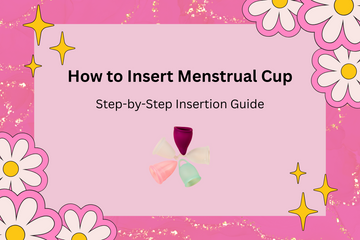Learning how to insert a menstrual cup can feel overwhelming at first, especially if you are trying it for the first time. But with the right guidance and some patience, it becomes a simple and empowering routine. Menstrual cups are a safe, eco-friendly, and cost-effective alternative to traditional period products like pads and tampons. However, their effectiveness largely depends on inserting them properly.
A correct insertion ensures comfort, a proper seal to prevent leaks, and allows you to wear the cup for up to 12 hours. In this menstrual cup insertion guide, we’ll take you through every step in detail, including tips for beginners, best techniques, and helpful advice to make the process easy and stress-free.
Understanding the Menstrual Cup
A menstrual cup is a soft, medical-grade silicone or rubber device shaped like a bell. It is folded and inserted into the vagina, where it collects menstrual fluid. Unlike tampons that absorb blood, cups collect it and can be emptied and reused. They’re known for being safe, cost-effective, and one of the most sustainable menstrual options.
Step-by-Step Menstrual Cup Insertion Guide
- Wash Your Hands and Cup Thoroughly Start by washing your hands with mild soap and warm water. Also, rinse or sterilize your menstrual cup before use, especially if it's your first time using it or it’s the beginning of your cycle. Clean hands and a sanitized cup are essential to prevent any infection.
- Get Into a Comfortable Position Position matters. Some beginners prefer sitting on the toilet, others squat in the shower, or stand with one leg raised on the toilet seat. Choose a position that helps you relax your pelvic muscles. Tension can make insertion more difficult and uncomfortable.
- Fold the Cup There are different folds you can try: the C-fold, Punch-down fold, and 7-fold are the most common. For beginners, the Punch-down fold is often easier to insert because it makes the insertion end smaller. Hold the fold firmly so the cup doesn’t pop open too early.
- Gently Insert the Cup Hold the folded cup with one hand and use your other hand to gently open your labia. Slide the cup into the vaginal canal at a slight angle toward your tailbone, not straight up. It should sit lower than a tampon but still completely inside. Once in, let it unfold naturally.
- Ensure It Has Fully Opened Once inserted, the cup should pop open to create a seal with the vaginal walls. This seal is what prevents leaks. To check if it has opened, gently run a finger around the base of the cup. If it feels flat or folded, you may need to wiggle or rotate the cup slightly to help it expand fully.
- Adjust for Comfort If the stem is poking out or feels too long, you can trim it slightly, but never while the cup is inside you. Some people prefer cups without stems. When placed correctly, you should not feel the cup at all.
- Check for Leaks If inserted correctly, there should be no leakage. If you experience spotting or discomfort, remove the cup and try again. Leaks often happen when the cup hasn't opened fully or is not positioned properly.
Menstrual Cup Insertion Tips for Beginners
- Stay relaxed. Tension can make insertion more difficult.
- Use a water-based lubricant on the rim of the cup to make insertion smoother.
- Try inserting the cup while in the shower to reduce mess and increase comfort.
- Practice during light flow days when you're less sensitive.
- Don’t worry if it takes a few cycles to get it right. That’s completely normal.
Common Mistakes and How to Avoid Them
One common mistake is inserting the cup too high. It should sit low in the vaginal canal. Another issue is not letting it fully expand. Always rotate or wiggle the cup to ensure it opens. Beginners also sometimes use the wrong fold. Experiment with different folding techniques until you find the one that works best for you.
When to Seek Help
If you consistently experience discomfort, pain, or leaks despite following this menstrual cup insertion guide, consult your gynecologist. It might be a matter of trying a different size or firmness. Inserting a menstrual cup should never be painful once you get the hang of it.
Benefits of Learning the Right Way to Insert
Correct insertion offers you long-lasting protection, increased comfort, and peace of mind. It allows for greater mobility, better sleep during periods, and reduces the need to change products frequently. Mastering the technique also means fewer leaks and less worry.
Final Thoughts
Mastering how to insert a menstrual cup may take a little practice, but it's worth the effort. This reusable, eco-friendly product offers long-term benefits once you're comfortable using it. Following this step-by-step method, especially if you're inserting a menstrual cup for beginners, will help you feel confident, clean, and leak-free every month.
FAQs
1. Can a menstrual cup get lost inside my body?
No. A menstrual cup cannot get lost inside the body. It sits below the cervix, and there's no way for it to travel beyond. If you can’t reach it easily, try relaxing or bearing down gently to bring it lower for easier removal.
2. Should I use lubricant when inserting a menstrual cup?
Yes. A water-based lubricant can be used to make insertion smoother, especially for beginners. Avoid oil-based products as they can degrade the silicone. Lubricants help reduce friction and make insertion less intimidating.
3. How do I know if the cup is inserted correctly?
The cup should sit low in your vaginal canal and feel comfortable. You shouldn’t feel any sharp edges or discomfort. It must pop open fully to form a seal. Check by running your finger around the base to ensure it's not still folded.
4. Is it okay to wear a menstrual cup overnight?
Yes. Menstrual cups are safe to wear overnight and can be used for up to 12 hours. Just make sure it’s inserted properly and emptied before bed. It offers leak-free protection and is perfect for uninterrupted sleep.
5. Do I need to remove the cup while using the toilet?
No. You can urinate and have bowel movements without removing your menstrual cup. The vagina, urethra, and anus are separate. However, you may want to check placement afterward to ensure it hasn’t shifted.
6. How far should a menstrual cup go in?
It should sit just below the cervix, not too deep like a tampon. It should be fully inside but low enough for the stem or base to be reachable. Inserting too high can cause leaks and discomfort.
7. Can teenagers use a menstrual cup?
Yes. Teenagers can use menstrual cups safely. Many brands offer smaller sizes for beginners. With proper guidance and practice, teens often find cups to be more convenient and eco-friendly in the long run.
8. What if my cup doesn't open after insertion?
Try rotating it gently or pressing at the base to release any folds. Some users also find that running a finger around the rim helps it open. You can also try a firmer cup or different fold technique.
9. How do I remove a menstrual cup easily?
Relax, squat or sit on the toilet, and pinch the base of the cup to break the seal. Don’t pull from the stem alone. Rock the cup gently side to side as you remove it to avoid discomfort.
10. Is there a right time during my cycle to practice insertion?
Yes. The best time to practice is during your period when your vaginal canal is naturally lubricated. Starting on a lighter flow day helps beginners get comfortable without dealing with a heavy mess.






